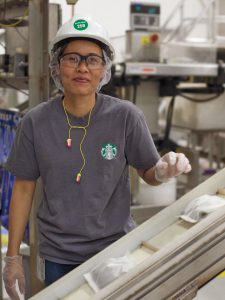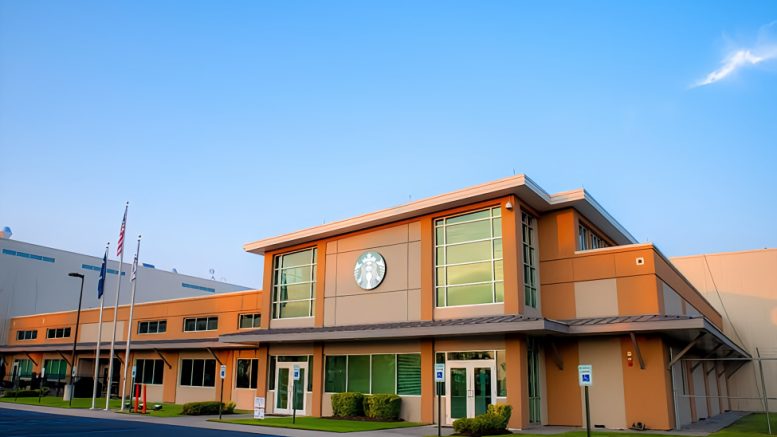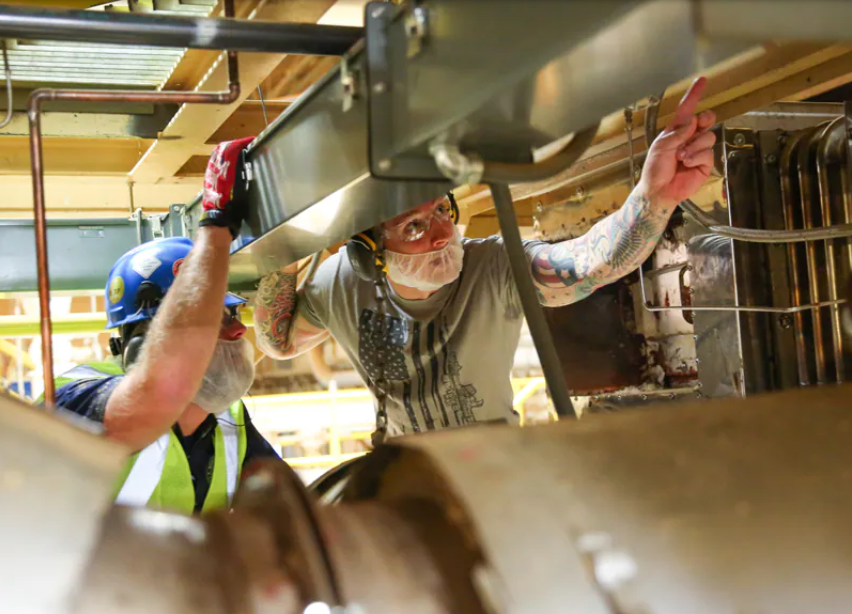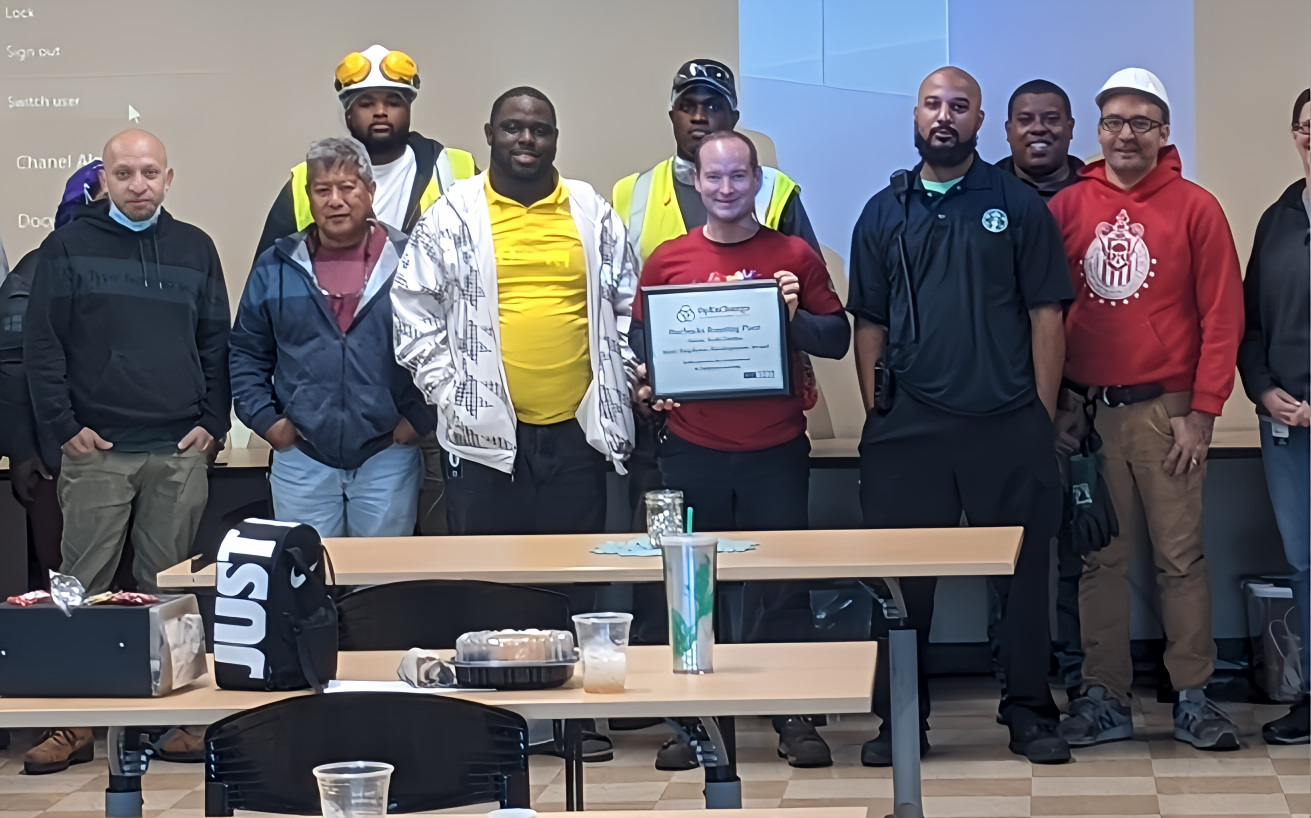The OpExChange visited the Starbucks Sandy Run Roasting plant in Gaston, South Carolina in early March. This plant is one of seven roasting plants in the world supplying ground coffee and whole beans to fuel the world. This facility opened in 2008 and recently celebrated their 15th anniversary.
Shawn Newcomb is the Site Director for the facility. His warm welcome included a Starbucks coffee tasting session where OpExChange visitors enjoyed a sample of their Anniversary Blend, featuring a dark roast crafted from specially selected coffee beans from Sumatra, West Java, and Sulawesi regions of Indonesia.
Shawn proceeded to give an operational overview of the plant history. He pointed out that their facility was designed differently than the other roasting plants in their network. Most of the other plants have a standard, linear flow with product progressing from one operation to the next. This facility, however, was laid-out to adopt a cellular concept, incorporating both the roaster and the packaging line.
There are six roasters in the facility and five packaging lines. They produce packages anywhere from 12-ounce bags up to 80-ounce bags. Shawn shared that 60% of their volume is shipped directly to the Starbucks retail stores with the remainder going to distribution channels. The site produced over 70 million pounds last year and is on track to repeat this in 2024.
The facility sets a high standard for food hygiene. They have earned the highest rating of “AA” in the BRCGS (Brand Reputation through Compliance of Global Standards). This signifies exceptional compliance with the BRCGS standards, demonstrating a high level of food safety and quality management.
They produce eighty different variants of coffee. One of the visitors asked where they purchased their coffee beans. Shawn answered, “That is one thing about Starbucks. We source coffee from all over the world. We have different recipes for our coffees. Some will call for a South American bean or you will have a twenty-five-year blend that will use a more aged Sumatra bean.” There are many different coffee types to satiate the varied palettes of their loyal customers.
Continuous Improvement Journey
 Sophia Perez is the Continuous Improvement Manager for the Sandy Run facility. She has been working for Starbucks for 17 years, beginning with her first job as a barista. Sophia walked us through their CI journey. She explained that while various problem-solving tools were employed in the past with good intentions, there was a noticeable absence of consistency and a sustainable program.
Sophia Perez is the Continuous Improvement Manager for the Sandy Run facility. She has been working for Starbucks for 17 years, beginning with her first job as a barista. Sophia walked us through their CI journey. She explained that while various problem-solving tools were employed in the past with good intentions, there was a noticeable absence of consistency and a sustainable program.
Their journey began in earnest in March of 2022. This began with a resetting of expectations around their visual daily management (VDM) boards on each of their lines. The VDM boards are a network standard display utilized in other Starbucks locations. The leadership team regrouped around these boards and established clear roles and responsibilities to ensure that there was follow-through on action items. It was important that everyone understood the need for these measures and was aligned on the part they played to ensure success.
Foundational 5S
A fundamental tool in the continuous improvement arsenal is 5S, a lean manufacturing methodology focused on organizing the workplace for efficiency and effectiveness. Recognizing its pivotal role, Shawn and his team the 5S methodology as a cornerstone in their CI Program. To kickstart this initiative, they sought lean manufacturing guidance from the SCMEP (South Carolina Manufacturing Extension Partnership). Their first event involved a cross-functional team of ten partners from across the site that focused on revitalizing their maintenance department. Sophia shared visual evidence of the transformation through before an after pictures. The transformation was significant. During the plant tour, everyone was able to observe firsthand evidence of the improvements in action.
Sophia emphasized the importance of maintaining their achieved progress before moving on to other areas. Following the initial project, they successfully implemented 5S in the QA Lab, Tasting Room, and the first production area in Cell 5.
Daily Management System
Over the past two years, the Starbucks Gaston facility has been refining and enhancing a tiered daily management system. This system is designed to offer a structured framework for overseeing and directing performance across various organizational levels, from floor operators to senior leadership. At Tier 1, during shift turnover, operators are tasked with reporting their production output and the top three downtime events for the shift. Tier 2 meetings involve frontline supervisors and managers engaging on a daily VMB (Visual Management Board) Walk, reviewing results from the previous 24 hours, discussing problem areas, and assigning actions. This walk is also conducted weekly to assess the overall weekly progress. These discussions culminate in Tier 3 metric reviews led by the site director.
Problem Solving – CI 301
Experience from previous plant visits has provided OpExChange members a glimpse into many Continuous Improvement (CI) programs across different locations. A recurring theme observed in these visits is the creation and cultivation of a strong culture of problem solvers. Recognizing the significance of this, Starbucks has instituted a training regimen known as CI 301. This weeklong program is conducted off-site and employs the PDCA (Plan, Do, Check, Act) methodology, commonly known as the “Deming cycle.” Within this training framework, participants are instructed in the utilization of the A3 problem-solving process, originally developed as part of the Toyota Production System. This method enables the creation of a succinct visual representation encompassing the problem, its analysis, and proposed solutions, all condensed onto a single 11×17 sheet of paper.
Such an approach fosters effective communication and collaboration among Starbucks partners. The training incorporates hands-on project work addressing real-world problems. Over the course of their two-year journey, all front-line supervisory team members and two-thirds of the management staff have completed this training. Presently, the factory is actively engaged in seven A3 projects. All supervisors are tasked with completing at least one A3 in the current fiscal year.
Shawn added that a key metric he tracks to measure proliferation of this culture is the percentage of partners that have participated in either a problem solving or 5S activity. Thus far, 31% of their workforce has participated in an event. Their current goal is to achieve 50% by the end of the current fiscal year.
A3 Event – Downtime Reduction with Unexpected Root Cause
Adam Co, a senior maintenance mechanic with over thirteen years of experience at Starbucks, was a member of one of the first A3 project teams. Adam shared his team’s journey and outcomes with the group. The team was tasked with addressing a significant increase in downtime caused by “miss-picks” on a packaging line, where packaged coffee is robotically transferred into corrugated boxes for shipment.
Miss-picks trigger costly downtime on the entire line, frustrating both operators and the maintenance crew responsible for troubleshooting. Adam emphasized the need for the A3 framework to dispel preconceived assumptions regarding the problem’s cause. While some suggested solutions such as acquiring larger corrugated boxes, Adam underscored the importance of identifying and rectifying root causes rather than addressing symptoms.
By systematically applying the A3 framework, the team conducted Gemba walks, process observations, and utilized the tools they learned in the CI301 course, including fault-tree analysis and run charts, to identify contributing factors and potential root causes. A pivotal revelation surfaced during the project: most contributing factors were originated downstream, not at the packing station as most had believed.
Implementing solutions and adhering to the PDCA cycle, the team surpassed their target downtime reduction for the current fiscal year. Adam stressed that sustaining these improvements hinges significantly on the visibility provided during daily Tier 2 meetings. They will still see an occasional spike in downtime, but the Tier 2 meeting was and continues to be the means for sustaining their improvements.
The Journey has Just Begun
Shawn emphasized that their official CI journey has only just begun. “We’re not claiming to have all the answers. We’ve learned a lot, and while we’ve excelled in certain areas, we acknowledge that we’re not perfect.” He added that he was looking forward to hearing suggestions coming from the visitors on improvements they could make to their program.
Shawn expressed pride in their workforce’s enthusiastic embrace of the concepts they are learning. This enthusiasm is not only evident in their internal metrics and involvement in Continuous Improvement (CI) activities but was also acknowledged by the OpExChange. In December 2022, they were honored with the annual “Employee Development Award.” Over the course of the year, fourteen different partners participated in twelve plant visits and workshops.
Shawn added that he is blessed with an extraordinary workforce. Many of their partners have been with them since the site opened. He noted that this is reflected in both their safety and cost results. The Sandy Run site leads the Starbucks network in safety results, and they are the low cost provider of all the Starbucks roasting plants. Their CI improvement journey is only going to further enhance their capabilities and performance.
At the conclusion of the tour, a collaborative session facilitated open discussions between Starbucks and their OpExChange peers. Visitors shared various observations they could apply at their own sites and offered suggestions for future enhancements in Starbucks’ Continuous Improvement journey.
About Starbucks
Starbucks’ story began in 1971 at Seattle’s Pike Place Market, inspired by the seafaring tradition of early coffee traders. In 1983, Howard Schultz visited Italy and was inspired to bring its warm coffee culture to Starbucks. By 1987, Starbucks embraced its coffeehouse identity with its iconic green aprons. Committed to quality and service, Starbucks meticulously crafts each cup from sourcing to roasting to brewing. Valuing its partners (employees), Starbucks fosters a culture of belonging. Beyond profit, Starbucks aspires to positively impact people and the planet through ethical sourcing, environmental sustainability, and nurturing human connections in communities worldwide. https://www.starbucks.com/
About OpExChange
The OpExChange, sponsored by the South Carolina Manufacturing Extension Partnership, is a peer-to-peer network of manufacturers and distributors in South Carolina known for generating success for members through benchmarking and best practice sharing. Member companies host events and share practical examples of industrial automation, lean manufacturing improvements, and leadership development. It is an invaluable resource to South Carolina companies that provides access to others who are on similar improvement journeys. If your company is interested in participating in this collaborative effort to improve both the competitiveness of your operation and South Carolina, contact Mike Demos (Mike@OpExChange.com). More information and upcoming plant visits are available on the OpExChange website www.OpExChange.com




Be the first to comment on "Starbucks Sandy Run Roasting Plant: Brewing Excellence Through Continuous Improvement"